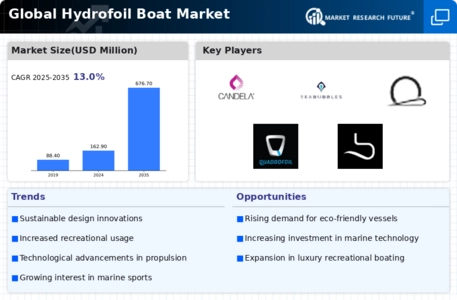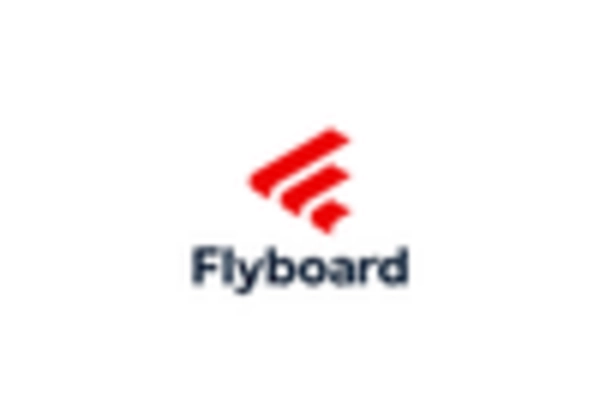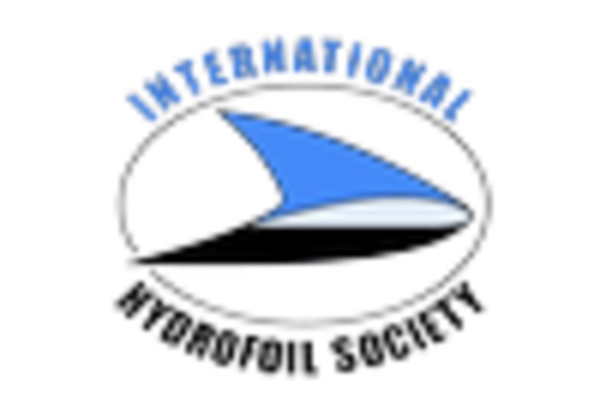Growth of Marine Tourism
The Global Hydrofoil Boat Industry is poised to benefit from the growth of marine tourism. As travel trends shift towards unique and immersive experiences, hydrofoil boats are becoming increasingly popular among tourists seeking adventure on the water. Destinations that offer hydrofoil boat rentals and tours are witnessing a rise in visitor numbers, contributing to the overall growth of the marine tourism sector. This trend is supported by data indicating that marine tourism has been expanding at a rate of 6% annually. The appeal of hydrofoil boats lies in their ability to provide a thrilling experience while exploring coastal and marine environments. Consequently, this growth in marine tourism is likely to drive demand for hydrofoil boats, encouraging manufacturers to expand their offerings and enhance their marketing strategies.
Environmental Sustainability Initiatives
The Global Hydrofoil Boat Industry is witnessing a growing emphasis on environmental sustainability. As concerns regarding climate change and marine pollution intensify, manufacturers are focusing on creating eco-friendly hydrofoil boats. These vessels are designed to minimize fuel consumption and reduce emissions, aligning with global sustainability goals. The use of electric propulsion systems and hybrid technologies is becoming more common, appealing to environmentally conscious consumers. Furthermore, regulatory bodies are implementing stricter environmental standards, which encourages innovation in sustainable boat design. This shift towards sustainability not only enhances the market's appeal but also positions hydrofoil boats as a viable alternative to traditional vessels, potentially expanding their market share in the recreational and commercial sectors.
Increasing Participation in Water Sports
The Global Hydrofoil Boat Industry is benefiting from the rising participation in water sports activities. As more individuals seek recreational activities that promote health and wellness, hydrofoil boating is gaining popularity due to its unique experience and thrill. The market is seeing an influx of new enthusiasts, particularly among younger demographics who are drawn to innovative water sports. According to recent data, the water sports industry has been growing at a compound annual growth rate of approximately 5% over the past few years. This trend is likely to continue, as hydrofoil boats offer an exhilarating way to engage with water sports, thereby driving demand and expanding the market. Manufacturers are responding by developing a wider range of hydrofoil models to cater to diverse consumer preferences.
Technological Innovations in Hydrofoil Design
The Global Hydrofoil Boat Industry is experiencing a surge in technological innovations that enhance performance and efficiency. Advanced materials such as carbon fiber and lightweight composites are being utilized to construct hydrofoils, resulting in improved speed and maneuverability. Additionally, the integration of smart technologies, including GPS and automated control systems, is becoming more prevalent. These innovations not only enhance the user experience but also contribute to safety and reliability. As a result, manufacturers are increasingly investing in research and development to create cutting-edge hydrofoil designs that cater to both recreational and commercial applications. The market is projected to grow as these technological advancements attract a broader audience, potentially increasing the market size significantly in the coming years.
Investment in Recreational Boating Infrastructure
The Global Hydrofoil Boat Industry is experiencing a positive impact from increased investment in recreational boating infrastructure. Governments and private entities are recognizing the economic potential of the boating industry and are allocating funds to develop marinas, docking facilities, and maintenance services. This investment not only enhances the overall boating experience but also encourages more individuals to engage in hydrofoil boating. Improved access to water bodies and better facilities are likely to attract a wider audience, thereby expanding the market. Additionally, the establishment of hydrofoil-specific events and competitions is fostering community engagement and interest in the sport. As infrastructure continues to improve, the hydrofoil boat market is expected to grow, driven by increased participation and accessibility.


















Leave a Comment